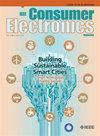Quantum Communication-Based Image Transmission With Transmit and Receive Diversity in MIMO Communication Systems
IF 10.9
2区 计算机科学
Q1 ENGINEERING, ELECTRICAL & ELECTRONIC
引用次数: 0
Abstract
Quantum communication systems have the potential to revolutionize media transmission technologies with unparalleled efficiency and reliability. However, practical and scalable implementations are challenged by issues such as channel fading and interference. To address these, we propose a novel approach combining quantum superposition with transmit and receive diversity schemes in Multiple-Input Multiple-Output (MIMO) systems, designed to mitigate the effects of fading for enhanced image transmission. In our simulations, images in JPEG and HEIF formats are channel encoded with rate 1/2 polar coding, converted into qubit superposition states, and transmitted through a 2x2 MIMO system with varied diversity schemes. At the receiver, a quantum decoder reconstructs the classical information, followed by polar decoding to retrieve the original image data. Our approach achieves notable improvements in image quality, with Peak Signal-to-Noise Ratio (PSNR) up to 58.27 dB for JPEG and 64.72 dB for HEIF, and Structural Similarity Index Measure (SSIM) up to 0.9994 for JPEG and 0.9999 for HEIF, outperforming classical systems, especially under low Signal-to-Noise Ratio (SNR) conditions, demonstrating the system’s enhanced ability to maintain image quality in noisy channels. These findings highlight the promise of quantum superposition-based media transmission to set new standards in reliable, high-fidelity communication for next-generation systems.MIMO通信系统中基于量子通信的收发分集图像传输
量子通信系统有可能以无与伦比的效率和可靠性彻底改变媒体传输技术。然而,实际和可扩展的实现受到诸如信道衰落和干扰等问题的挑战。为了解决这些问题,我们提出了一种将量子叠加与多输入多输出(MIMO)系统中的发射和接收分集方案相结合的新方法,旨在减轻衰落对增强图像传输的影响。在我们的模拟中,JPEG和HEIF格式的图像以速率1/2极性编码进行信道编码,转换成量子比特叠加状态,并通过具有不同分集方案的2x2 MIMO系统传输。在接收端,量子解码器对经典信息进行重构,然后进行极坐标解码,获取原始图像数据。我们的方法在图像质量方面取得了显著的改善,JPEG的峰值信噪比(PSNR)高达58.27 dB, HEIF的峰值信噪比(PSNR)高达64.72 dB, JPEG的结构相似指数(SSIM)高达0.9994,HEIF的结构相似指数(SSIM)高达0.9999,优于经典系统,特别是在低信噪比(SNR)条件下,表明系统在噪声通道中保持图像质量的能力增强。这些发现强调了基于量子叠加的媒体传输的前景,为下一代系统建立可靠、高保真通信的新标准。
本文章由计算机程序翻译,如有差异,请以英文原文为准。
求助全文
约1分钟内获得全文
求助全文
来源期刊
CiteScore
7.70
自引率
9.30%
发文量
59
审稿时长
3.3 months
期刊介绍:
The main focus for the IEEE Transactions on Consumer Electronics is the engineering and research aspects of the theory, design, construction, manufacture or end use of mass market electronics, systems, software and services for consumers.

 求助内容:
求助内容: 应助结果提醒方式:
应助结果提醒方式:


